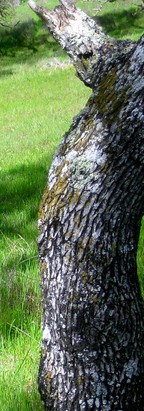Oak Bark

The only living part of a tree is the cambium layer - it is seen as the green part of a twig when you break it open. This cambium layer actually consists of two layers - the one that enlarges the woody part of the tree is called the xylem and the other layer, called the phloem, makes more bark. After all, as the tree grows, new (larger) bark must also be formed to cover the increasing size of the tree. Thus the newer bark is always larger than the older part directly above it and the older part of the bark gets pushed outwards as the tree continues to add girth.
Therefore, if you could gather all of the oldest bark on the outside of a tree you would be able to measure how big that tree was when that bark was formed. One of the reasons a tree grows only to a certain height is that most of the energy in a middle-aged tree is going to make the tree wider and wider, rather than growing taller. For example, if you look at the "tree rings" on an old cut-off trunk, you'll see wide growth rings in the center and narrow rings towards the outside. The wide rings were formed during the trees "teenage years" when it was shooting skyward. Once it reached some magical height, its energy was then devoted to making the tree fatter. Much of this is a parallel to human life, where teenagers shoot up to their adult height and then thicken as the years go beyond 20 or so years old. Some of us are too thick!
Jerry Fritzke
February 26, 2003




 Join/Renew
Join/Renew Donate
Donate Volunteer
Volunteer Maps
Maps Newsletter
Newsletter Facebook
Facebook
